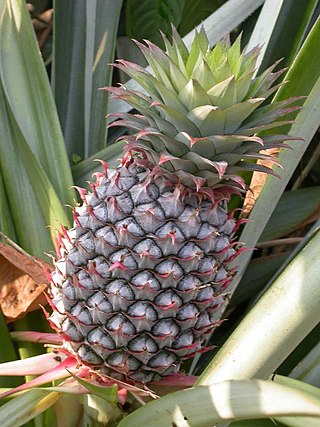
The Bromeliaceae are a family of monocot flowering plants of about 80 genera and 3700 known species, native mainly to the tropical Americas, with several species found in the American subtropics and one in tropical west Africa, Pitcairnia feliciana.

Brocchinia reducta is a carnivorous plant in the bromeliad family. It is native to southern Venezuela, Brazil, Colombia, and Guyana, and is found in areas with nutrient-poor, high moisture soil. B. reducta is able to grow in sparse conditions, which is evident when it uses its roots as anchors over rocks. Its funnel-like structure and waxy coating, among other characteristics, suggest that this plant is carnivorous.

Catopsis berteroniana, commonly known as the powdery strap airplant or the lantern of the forest, is an epiphytic bromeliad thought to be a possible carnivorous plant, similar to Brocchinia reducta, although the evidence is equivocal. Its native range is from southern Florida to southern Brazil. It generally grows on the unshaded twigs of trees, and has been shown experimentally to trap more insects in its tank than other bromeliads of comparable size. There are several other species in the genus, none of which is believed to be carnivorous.
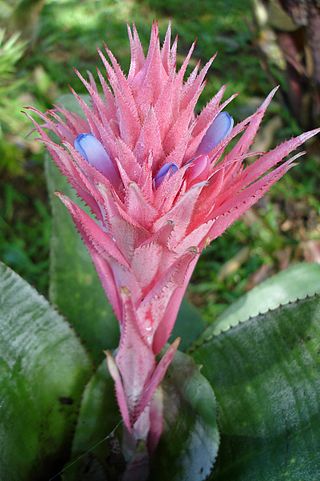
Aechmea is a genus of flowering plants in the family Bromeliaceae. The name comes from the Greek aichme, meaning "spear". Suggested pronunciations include EEK-me-ə and eek-MEE-ə. Aechmea comprises eight subgenera and around 250 species distributed from Mexico through South America and the Caribbean. Most of the species in this genus are epiphytes.

Aechmea bromeliifolia is a bromeliad native to southern Mexico, Central America, Trinidad, and South America as far south as northern Argentina.
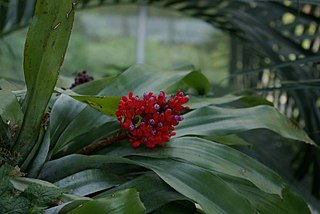
Aechmea fulgens, the coralberry, is a bromeliad, which is often used like an ornamental plant. This plant grows in Brazil, especially in following states: Bahia and Pernambuco. It has an upright open rosette shape and after blooming, becomes a reddish orange. It blooms one time before dying.

Aechmea blanchetiana, also known as orangeade bromeliad, is a common bromeliad species found in the restingnas vegetation along the Atlantic Coast which is part of the Atlantic forest biome in eastern Brazil. This plant grows from the State of Bahia south to Espírito Santo. It is common worldwide in tropical and sub-tropical regions for its use as an ornamental plant.

Aechmea nudicaulis is a bromeliad species in the genus Aechmea, which is often used as an ornamental plant. This species is native to Central America, the West Indies, central and southern Mexico, and northern and central South America.

Aechmea tillandsioides is a bromeliad widespread across southern Mexico, Central America, and northern South America. It is widely cultivated in other regions as an ornamental plant. This plant is cited in Flora Brasiliensis by Carl Friedrich Philipp von Martius.
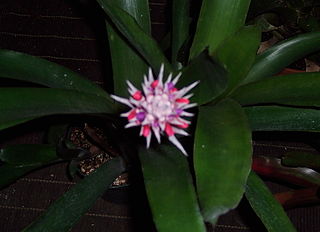
Aechmea dealbata is a bromeliad in the subfamily Bromelioideae. This plant species has spiny green foliage with a complex pink and purple inflorescence. It is epiphytic but will grow in soil and is commonly cultivated. This species is endemic to the State of Rio de Janeiro in Brazil.

Mulford Bateman Foster was a botanist known by many as the "Father of the Bromeliad" as he was instrumental in the discovery and introduction of many new species of Bromeliad to the United States. He also devoted his life to hybridizing and contributed widely to the knowledge of the plant species. He was a man of many talents including naturalist, explorer, writer, photographer, artist, horticulturist and a well-respected landscape architect in Florida. Numerous bromeliad plants found today are named after various Foster family members and the genus Fosterella is named in honor of his work.

Aechmea paniculigera is a plant species in the genus Aechmea. It grows in Colombia, Venezuela and Jamaica.
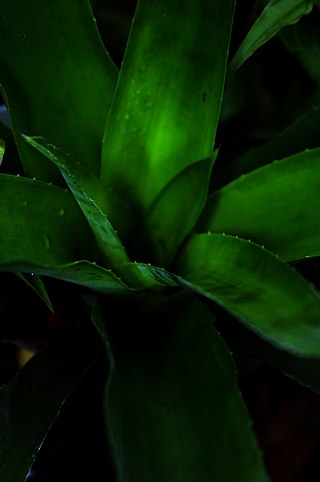
Chevaliera is a subgenus of the genus Aechmea.

Lamprococcus is a subgenus of the genus Aechmea.

Platyaechmea is a subgenus of the genus Aechmea.
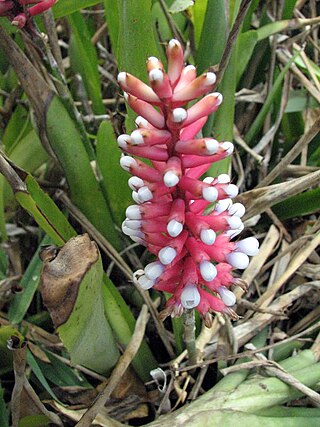
Ortgiesia is a subgenus of the genus Aechmea.
Aechmea candida, the white bromeliad, is a species of bromeliad in the genus Aechmea. This species is endemic to Brazil, where it can be found in Bahia, Espírito Santo, Santa Catarina and Rio Grande do Sul, from sea level up to 150 m elevation. It is an epiphyte found growing in rocky, moist and shady areas in the thick forests. It is threatened by agriculture, urban development and logging. It is found in protected areas of the Atlantic Forest, and is cultivated in a number of botanical institutions.
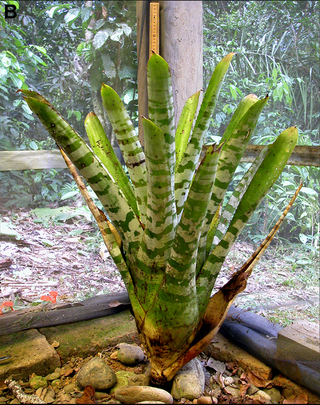
Aechmea zebrina is a plant species in the genus Aechmea. This species is native to Ecuador and Colombia; it is relatively common in the lowland Amazon region of eastern Ecuador and southern Colombia.

Aechmea smithiorum is a plant species in the genus Aechmea. It is a medium-sized bromeliad with broad green leaves and a striking white rosette.
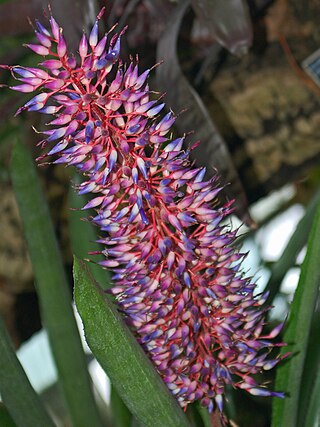
Aechmea subg. Aechmea is a subgenus of the genus Aechmea.


















